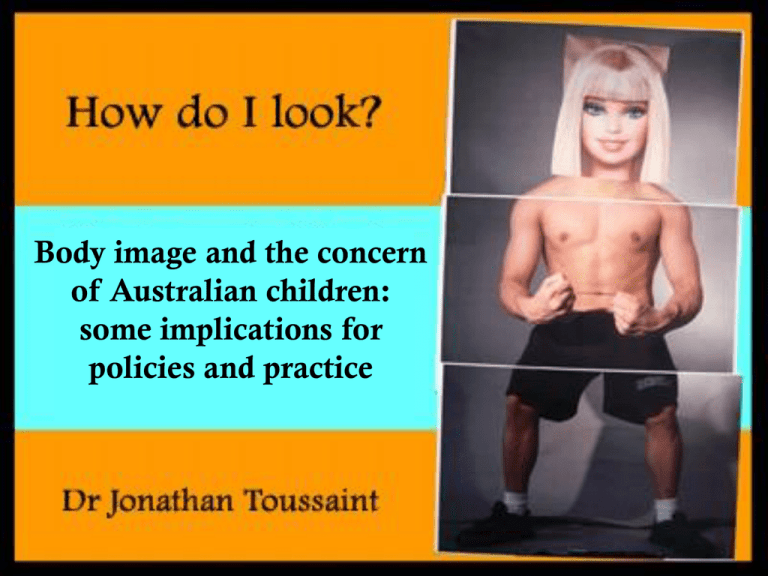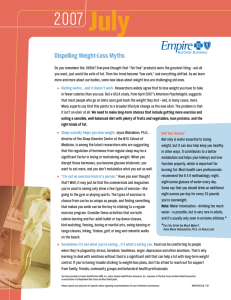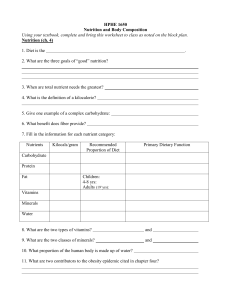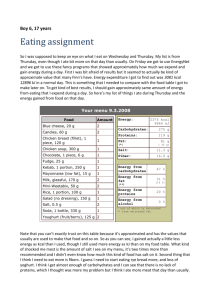
Body image and the concern
of Australian children:
some implications for
policies and practice
Interrelate........
a leading Australian provider of
• counselling for
individuals, couples,
and families
• parenting and
relationship education
• employee assistance
programs and
consultancy for
companies
• support for families
going through separation
• training for family
support professionals
• Sexuality and
relationship education
• workplace counselling,
mediation and training
The 1930’s
2011
Issues of Concern
%
Body image
32.3
Family conflict
29.3
Coping with stress
26.9
School or study problems
25.4
Suicide
23.9
The environment
23.4
Bullying/emotional abuse
22.7
Physical/sexual abuse
21.2
Alcohol
20.5
Drugs
20.1
Depression
19.6
Self harm
14.7
Discrimination
12.9
Sexuality
9.6
Alcohol & other drug issues
N/A
(Mission Australia National Survey of Young Australians – 2010)
Body Image Crisis
• Body image the #1 concern of young Australians for 4 consecutive
years
• Overwhelming evidence that exposure to thin-ideal significantly
increases risk of body dissatisfaction, which in turn significantly
increases risk of pathological eating and dieting behaviours
• Increasing rates of eating disorders, pathological dieting behaviours
in young Australians – including boys
Body Image Statistics
Children are influenced by their parents, peers and the media:
• 42% of primary school students want to be thinner
• 80% of children who are ten years old are afraid of being fat
• 25% of men and 45% of women are on a diet on any given day
• 80% of women are dissatisfied with their appearance
• 51% of 9 and 10 year old girls feel better about themselves if they are on a diet
• 35% of “normal dieters” progress to pathological dieting. Of those, 25% will
progress to partial or full syndrome eating disorder:
Anorexia Nervosa - pursuit of thinness that leads to self-starvation
Bulimia Nervosa – a cycle of bingeing followed by extreme behaviours
to prevent weight gain, such as purging
Binge Eating disorders – regular bingeing
• 91% of girls recently surveyed on a university campus had attempted to control
their weight through dieting.
The diet industry is a 40 billion dollar industry. This figure is amazing
considering 95% of all dieters will regain their lost weight within 1-5 years.
(The Butterfly Foundation) Supporting Australians with Eating Disorders
What is body image?
Body image is the mental picture we have about the way we think we look. It’s
how we feel about the size, shape, weight, and look of our bodies.
Body image disturbance is also a significant mental and physical health issue,
resulting in disordered eating patterns, extreme weight control methods,
excessive exercise, and substance abuse.
Problems with body image affect men and women. Most people face it at some
stage of their life.
Boys face pressure to tone-up, muscle-up and look big,
strong and tanned.
Girls face pressure to slim-down, tone-down and look petite
and small.
•
Develops at birth
•
Our culture reinforces it – we learn it from family
members, peers, media
•
Children are susceptible and vulnerable to external
stimuli and media influences
•
A premium on staying thin
What was the childhood message given to
you (verbal or unspoken) about the way you
looked?
How has that affected your worldview and
formed your beliefs in adulthood?
How does that play out in your relationship
with your children?
Obsessed: Young girls are growing up
with a more negative body image than
ever before.
Starving Tip of The Day!
“………Let me be empty and weightless
and maybe I'll find some peace tonight”
Sarah McLachlan “In the arms of an Angel”
90210 star Anna Lynne McCord
skinny, thin, tummy
Same pose, same fonts, same boring ‘advice’
stories. Women are buying the same
magazine every month!
Britney Spears loses diet
battle
Britney Spears has grown up right before our eyes. Who can forget the young star on the cover
of Rolling Stones Magazine? The beautiful singer is known for her sexy, bikini abs.
Lately, Britney Spears’ fat has become news. Britney is not a young, teenager any more. The
cheetos, frappucinos, and big gulps have caught up to her. Her ripped abs has been seen as more
of a jelly belly. And rolls have gathered on her backside.
“Britney Spears
waddles through
MTV Music Awards”
—adrants.com
“She was like a drunk
elephant…”
–The Blemish.com
“She looked like a tick
getting ready to pop”
–AOL blogger sunshine5u56
“Britney looked like a
hog stuffed into that
bikini!” –AOL blogger psbrig
“No longer boasting the buff
body that helped drive
her to international
superstardom…”
–Reuters news service
“The bulging belly she was
flaunting was SO not
hot.”
–E! Online
“She’s a tubby piece of shit”
–WWTDD.com
“Maybe she should stick
her finger down her
throat to lose a few
lbs?”
–AOL blogger pinksodapop000
Here are some pictures of just-wed Kate Middleton doing some lastminute preparations and arrangements for her wedding on
Wednesday afternoon in London…
Responses to “Kate Middleton Candids”
• She recently got quite a bit thinner than she used to
be……..a classic beauty. Royalty is written all over
her.
• She looks pretty here, amazing at the wedding
today……..very skinny upclose.
• Kate is very, very skinny (for 5′10″). There were
“rumors” that she had gotten down to around 110 lbs.
She has such a tiny waist …and she looked absolutely
breath-taking today in her wedding dress. (very “Grace
Kelly-ish”). Kate is gorgeous I think that she is a
beautiful woman…..so skinny!
• great body
• very thin, beautiful! *jealous*
•TINY, TINY WAIST!
"ANA'S SONG (OPEN FIRE)"
By Daniel Johns/Silverchair
Please die Ana
For as long as you're here, we're not
You make the sound of laughter
And sharpened nails seem softer
And I need you now somehow
And I need you now somehow
Open fire on the needs designed
On my knees for you
Open fire on my knees desires
What I need from you
Imagine pageant
In my head the flesh seems thicker
Sandpaper tears corrode the film
And I need you now somehow
And I need you now somehow
Open fire on the needs designed
On my knees for you
Open fire on my knees desires
What I need from you
And you're my obsession
I love you to the bones
And Ana wrecks your life
Like an Anorexia life
Open fire on the needs designed
On my knees for you
Open fire on my knees desires
What I need from you
Open fire on the needs designed
Open fire on my knees desires
On my knees for you
Grammy®-nominated singer/songwriter
Lisa Loeb
“She’s Falling Apart”
They pull up their chairs to the table
She stares at the food on her plate
At the toast and the butter
Her father, her mother, she pushes away
And they rise in the morning
And they sleep in the dark
And even though nobody’s looking
She’s falling apart
She gets home from school too early
And closes the door to her room
There’s nothing inside her
She’s weak and she’s tired of feeling like
this
•25%
of males are on a weight loss diet at any given time
•Worry about being muscular, that means over-exercising and the use of
dangerous and illegal drugs (like steroids) are on the rise.
•A negative body image encourages a range of self-destructive
behaviours like:
- eating disorders (1 in 10 people with anorexia is now male),
4% of men are purging (vomiting or exercising compulsively,
also known as bulimia), about 3% of men have problems with
binge eating.
- exercise dependence (around 20% of regular exercisers are
addicted to exercise, either psychologically or physically).
- steroid abuse (around 3% of Australian teenage boys use
muscle enhancing drugs like steroids).
Better Health 15/5/2011
Some of the factors that contribute to a negative body image include:
Teasing in childhood (too thin, too weak, too fat)
Peer pressure among boys to be tough and strong (the male code)
Cultural tendency to judge people on appearance
The emphasis on male sports players as role models for boys
Advertising campaigns and media images featuring idealised male
images
Promotion by society of the ideal man as always being strong, lean
and muscular
Public health campaigns that urge people to lose weight
Eating Disorders Foundation of Victoria 2011
Looks and body shape are major focuses for bullies.
When asked about the "focus" of the bullying, "looks" were a factor in 55 percent of
the reported incidences. "Body shape" was a factor in 37 percent of the cases followed
by race (16 percent), sexual orientation (14 percent), family income (13 percent),
religion (12 percent), and disability (8 percent).
Credit: Youth Voice Research Project
Fat Prejudice
“This is the problem. The fatter we get, the more acceptable it
becomes to society. There are so many disgusting fat people out
there, just go to your local shopping centre and see giant mum and
dad with little fat kids following. I see women in beauty parlours
getting their toenails manicured. What's the point, their guts are so
big, they won’t see the results. Work on your body, not on your
feet. It’s assault to my eyes. I have no shame laughing in their face,
they deserve it. Stop making bigger clothes, ambulances, plane
seats, and make them suffer in embarrassment and stay indoors
until they look normal. Fat people suck”
-AP, in response to an article by Sue Dunlevy
in the Sydney Morning Herald
Body Image & Fat Hatred in
Preschoolers & Young Children
The aversion toward chubbiness has been shown to begin at a very young age. According to
research conducted in 2009 by the University of Central Florida and reported in the British Journal of
Developmental Psychology, nearly half of three- to- six year old girls worry about being fat.
Body image and weight studies have shown that negative attitudes towards children who are
considered “overweight” and “fat” in general have been detected in children as young as preschool-age
children.
Here’s some study results in a nutshell:
•Thin means you’re nice and fat means you’re mean
•Thin means I want to play with you and fat means I don’t want you as a friend
•Thin means I like you, fat means I don’t, and fat means “I don’t want to look like you at all”
•Thin means we prefer you
•Fat means we least prefer you
Clearly, children have accepted the stereotypes about body size and weight perpetuated by
society by five years of age.
•Heavier can mean body dissatisfaction and negative feelings
•Parental concerns and food restrictions can lower body esteem
•Aesthetic sports can make an impact
•Parents and Teachers can send the message
•Some parents are resorting to putting their babies on diets
•Eating Disorders are “exploding” for kids under 12
The Word On The Street
In a teen’s world, words have tremendous power. Here are thirteen
terms that have become a part of the daily body-bashing lexicon.
Muffin Top
Tits on a Stick
Teacher’s Elbow
Fit Chick
Pooch
Curvy Chick
Bra Bulge
Fat Chicks (also called Thick Chicks)
Cankles
Midsized Fat Chicks
Back Fat
Supersized Fat Chicks
Stick Chick
When…………
•
a person’s value and worth, comes only from their appearance (body
image), or sexual appeal and behaviour
•
sexuality is inappropriately imposed
•
a person is sexually objectified
…………it is known as
‘sexualisation’
Submission to the Inquiry into the
sexualisation of children in contemporary
media
Senate Standing Committee on Environment,
Communication and the Arts
April 2008
Summary of main findings
• Cognitive effects
• Depression, self-esteem and eating disorders
• Sexual
development
• Identity development; attitudes and beliefs
• Societal effects
Effects of sexualising material
The values implicit in sexualised images are that physical appearance and
beauty are intrinsic to self esteem and social worth, and that sexual
attractiveness is a part of childhood experience. Sexualisation occurs
when:
•A person’s only ascribed value comes from his or her sexual appeal and behaviour, to
the exclusion of other characteristics
• A person is held to a standard that equates physical attractiveness with being sexy
•A person is sexually objectified, and rather than being seen as a person with the capacity for
independent action and decision making, is made into a thing for others’ sexual use
• Sexuality is inappropriately and prematurely imposed upon a persons such as a child
(Australian Psychological Society, 2008)
Toddlers in high heels……
I stumbled across this article and I nearly rolled out of my chair in disgust that a set
of mothers would actually design high heeled shoes for infants and toddlers (and
use their own children to model them, mind you)...sickening? Absolutely. Not only
does this further the exploitation of women, but it's over sexualizing young girls (at
SUCH a young age). It just keeps getting worse and worse for the next generation of
females. Just look at the picture below. The baby is adorable, but the shoes make her
seem like a infant version of Carrie Bradshaw. Where is the world coming to?
High heels for babies 'sexualising infants'
They come in pink satin, black, even leopard and zebra print - high
heels designed for babies aged up to six months.
But horrified mothers see them as a new low in the campaign to
sexualise infants not old enough to know what is happening to them.
Too much, too young? Retailers still selling over-sexualised
clothing to kids
• Survey finds top chains offer inappropriate
items
•Retailers face pressure to remove clothes from
sale
Two of the heeled shoes being sold to fit eight-year-olds.
OH NO THEY DIDN'T!!! COMPANY MAKES HIGH HEELED SHOES
FOR TODDLERS!!!
Effects of sexualised media on girls
According to the APA's study, media images of sexy girls and adults
posing as adolescents 'sexualises' girls, harming them both physically
and psychologically.
The report defines 'sexualisation' as when:
•a person's value comes only from his or her sexual appeal
or behaviour
•sexuality is inappropriately imposed
•a person is sexually 'objectified'.
Other tee shirts……….
•"The condom broke"
•"Pardon my nipple breath"
•"I’m living proof my mum is easy"
•"I’m a tits man"
•"Mummy likes it on top"
•"Wipe my butt sucker"
•"So hot right now"
•"I like big boobs and I cannot lie"
•"I’m bringing sexy back"
•"Practice safe sucks".
Toddler Beauty Pageants
• 6 years old
• dubbed prettiest girl in America
• works the red carpet like a show-biz pro
• hectic schedule - diva like demands
• stacked heels, lip gloss, ostrich feathers,
fake tan
• $20,000 to secure an audience
• bringing her child beauty pageant to
Australia
Increasing Number of Young Boys Participating in Beauty
Pageants
Good Morning America reports on
the rise in the number of little boys
participating in beauty pageants
ABC News writes about a
significant increase in the number
of American boys who are
competing in toddler beauty
pageants. An estimated 10 percent
of contestants are now boys, up
from 5 percent five years ago.
Kyle Pickering is already a pageant title holder
at the age of 3.
San Francisco child protective services is investigating a mother
who sparked international outrage this week after telling a
national television audience that she had injected her 8-year-old
daughter's face with Botox to make her more competitive in
beauty pageants.
May 2011
The Australian…….
Cotton On vows to withdraw offensive t-shirts
CLOTHING company Cotton On has admitted it
"crossed the line" and today vowed to withdraw a range
of offensive children's t-shirts, including one making
light of child abuse, after a consumers threatened a
boycott.
A t-shirt emblazoned with the slogan "They Shake Me''
was the last straw for many angry parents, who sent
emails and Twitter messages to the company this
morning expressing their disgust and an intention to
vote with their feet.
Last month Cotton On had stuck by its range of shirts,
which included slogans such as "I'm a tits man'' and
"I'm living proof my mum is easy'', saying there was a
place in the market for their "edgy'' humour that
pushed the boundaries.
But today, as anger spread through the social
networking sites, Cotton On finally cottoned on to their
customers' feelings, offering a contrite apology and a
promise to withdraw the offending items from sale.
The Australia Institute
Corporate paedophilia:
the sexualisation of children in
Australia
The sexualisation of Australian children in
the interest of corporate profit is increasing
and exposes children to a wide range of
risks from a very young age, according to an
analysis by Emma Rush and Andrea La
Nauze. Children are increasingly being
portrayed in clothing and posed in ways
designed to draw attention to adult sexual
features that they do not yet possess in the
interest of the corporate bottom line.
Corporate Paedophilia: The sexualisation of
children in Australia.
Images of sexualised children are
becoming increasingly common in
advertising and marketing
material. Children who appear
aged 12 years and under,
particularly girls, are dressed,
posed and made up in the same
way as sexy adult models.
‘Corporate paedophilia’ is a
metaphor used to describe
advertising and marketing that
sexualises children in these ways.
The metaphor encapsulates the
idea that such advertising and
marketing is an abuse both of
children and of public morality.
Dressed provocatively
in a perilously short
dress, fishnet tights and
high-heeled PVC
dominatrix boots, this
is Noah Cyrus and she's
just ten years old
The cumulative exposure of children and young
people to sexualised images and themes has
negative effects.
• Self
objectification
• Depression,
self-esteem and eating disorders
• Sexual development
• Identity development, attitudes and beliefs
• Societal
effects
So how can parents teach children to value themselves, and
appreciate their body type?
• Don’t make food a big issue
• Never mention the word ‘diet’
• Get the children involved with the cooking
• Make meal times a stress free family occasion
• Make sure dads don’t make comments about their daughter’s weight.
• Don’t use food to feed emotions
• Compliment your child’s body on what it does - not how it looks
• Give them tools to deal with the pressures so they don’t turn to food for comfort
• Praise your teenager for their achievements and qualities rather then their
appearance
• Teach children media awareness
• If your teenager is too harsh about their appearance, remind them that
nobody, not even the celebrities are completely satisfied with the way they
look
• Listen to them
• Make sure your children can talk to you and that you hear what they’re saying not what you want to hear
Fathers’ Contribution to
Children’s Well-being
• Increased self-confidence, self-reliance and assertiveness
• Higher academic achievement and career advancement, most notably in the
fields of science, math and technology
• Better able to avoid teen pregnancy, early marriage and emotionally or
physically abusive relationships
• Better equipped to resist peer pressure regarding issues such as premature
sex, smoking and eating disorders
• More sociable and better able to work with people in authority, such as
teachers or employers
• Show more willingness and readiness to try new things and take on
challenges
Father Emotional – Detachment :
A health issue for daughters.
The father-daughter relationship is a “core-relationship” for females.
This relationship is fundamentally critical, to healthy psychosocial
development, for ALL women.
Dr. K. Davis-Johnson Northcentral University, 2010
Pre-adolescent girls who are raised without a consistent
healthy father-daughter relationship may:
• Have eating disorders
• Have poor body image
• Score poorly in school work
• Engage in “boyfriend-girlfriend” activity as early as 7,8,9 years old
Teen girls who are raised without a consistent, healthy father-daughter
relationship may:
• Have poor sense of self and self esteem
• Develop a poor body image
• Are not academically motivated
• Hyper-focus on acquiring male attention through appearance and
emotionally/physically dangerous activities
• Engage in promiscuous activities which can result in STI’s
• Become teen parents
• Have low standards, supported by the unconscious idea that she doesn’t
deserve REAL love
• Engage in substance misuse / abuse
• Have depression
Women who were raised without a consistent, healthy father-daughter
relationship may display:
• Deep-seated rage and anger
• Emotionally triggered deregulated, argumentative behaviour
• Doormat behaviour
• Poor male-female communication skills
• Inability to maintain healthy, long-term intimate relationships
• Enmeshed relationships with their sons
• Father hunger
• Depression
Educating fathers, and mothers about what their daughters need from
their fathers, can help decrease the numbers of fathers who love, but
do not know how to emotionally connect with their daughters.
New Australian research suggests ‘rough and tumble play’ - such as that
between children and fathers - may be central to emotional and brain
development. Children are better able to govern thoughts and emotions and it is
a first step towards quantifying the special role of fathers in helping children
develop coping skills through exploration and testing limits. ''It's not about IQ,
it's about the ability to sustain attention and focus.''
Dr Richard Fletcher (University of Newcastle, 2011)
14 Signs that your child may have an
eating disorder
1. Erratic food habits
8. Compulsive exercising
2. Playing with food
9. Skipping meals consistently
3. Restricting food intake
10. Measuring self-worth based on
weight
4. Major changes in weight in a short
amount of time
5. Hiding her body even after weight
loss
11. Complaining about being
overweight and fat when she clearly
underweight
12. Missing several periods in a row
6. Hiding food
13. Overall poor body image
7. Refusal to eat when others are
present
14. Spending a lot of time in the
bathroom
Strategies to reduce or prevent the proliferation of
sexualised images:
• Media
regulation
• Parents
• Schools
• Initiatives
by young people
Collective Shout is a new grassroots campaigns
movement mobilising and equipping individuals and groups to
target corporations, advertisers, marketers and media which
objectify women and sexualise girls to sell products and
services.
Collective Shout will name, shame and expose
corporations, advertisers, marketers and media engaging in
practices which are offensive and harmful especially to women
and girls, but also to men and boys.
Collective Shout is for anyone concerned about the
increasing pornification of culture and the way its messages
have become entrenched in mainstream society, presenting
distorted and dishonest ideas about women and girls, sexuality
and relationships.
UK report on the Commercialisation and Sexualisation of Childhood.
It should be said that the Australian Government was seen to be leading
the way on this issue, when it held a senate inquiry into the sexualisation of
children in the contemporary media environment back in June 2008. But the UK
has now left us in its tracks....
In Australia there has been little to zero action on the recommendations
from the 2008 inquiry. The review promised 18 months later has never happened.
Recommendations from the Australian inquiry stated that although
sexualisation is a societal issue and we are all responsible, the onus must lay
with industry - that is advertisers, marketers, retailers, broadcasters...
In that time there has been absolutely no indication of proactive
responsibility from industry.
We challenge the Australian Government to pay heed to the increasing
research and major concerns expressed by child psychiatrists and child
psychologists.
Enough reports..enough recommendations...enough finger wagging at
the industry...time for action!!
Body image and the concern
of Australian children:
some implications for
policies and practice





